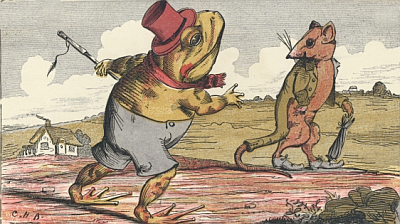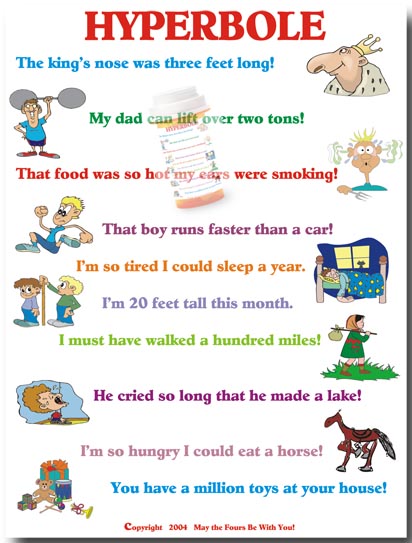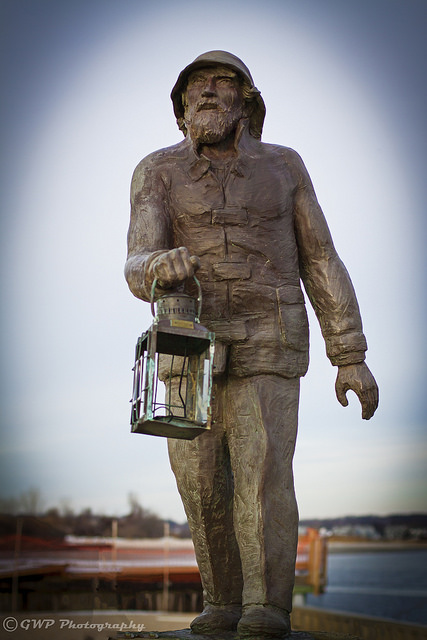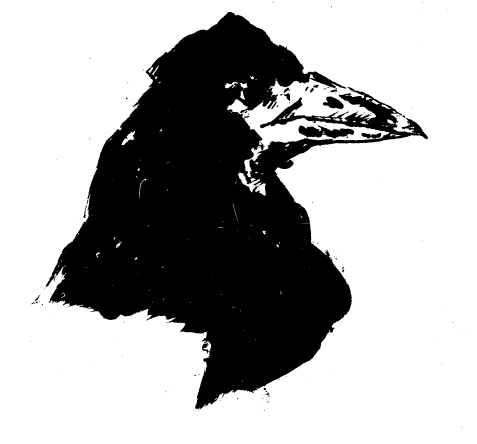Personification

Source: A Frog He Would A Wooing Go, Charles. H. Bennett, Project Gutenberg
Now let’s look at some other specific kinds of figures of speech, beginning with personification. First, take a close look at the word. Do you see a root word in there somewhere? Yes, person is part of the word “personification”, and it is there for a very good reason: Personification simply means making non-persons (e.g., trees, animals, objects) act like people. In the picture above, the toad and the mouse appear to be standing on two legs instead of four, talking to one another, and generally carrying on as if they were human beings. Personification is easy to identify when you’re reading about animals because you tend to think of them like humans. It gets harder when we see examples of personification that don’t have to do with animals but with other living things or inanimate objects. See if you can find the examples of personification in the paragraph below.
In the paragraph below, click on each example of personification. If you are correct, the example will highlight. You should find six examples.

I left the house and walked toward the beach in the cold blue night. The stars seemed to wink at me as I looked up at them. The sea had been angry that day, but now the gentle wind kissed my cheeks as I strolled along the beach. I was happy to be back in familiar territory where the sun marched its way toward the horizon every day and the black night gave a sense of finality to the long day. Where I had been, the city never slept with its sirens, bright lights, and honking horns. Though my friends urged me to come back, telling me the party was dead in my absence, I was content and safe in my familiar surroundings.
Do you see how personification helps you form images in your mind? Those images then help you have a better understanding of what the writer is saying.
Hyperbole
“Hyperbole” (pronounced hy-PER-bo-le) is perhaps an unfamiliar word, but it has a simple meaning: exaggeration! Click on this video to see a few musical examples of hyperbole.

Source: Hyperboles in Music, ksb6326, YouTube

Source: Hyperbole, Bill MacDonald, Flick
Hyperbole has been used throughout literature for many centuries to add drama or comedy to situations. Modern tall tales make use of hyperbole to exaggerate the feats and characteristics of their main characters. For example, the American tall tale about Paul Bunyan relies heavily on hyperbole to establish Bunyan’s giant stature and abilities. Hyperbole is also frequently used in comedy to offer a humorous description of somebody or something. In the cartoons about Wiley Coyote and Road Runner, the road runner always treats the poor coyote to a trick that involves hyperbole: an enormous lead weight falling on him or enough dynamite to blow up more than just one coyote!
The fields of advertising and propaganda use hyperbole almost exclusively, which has led to its having a somewhat negative connotation. Typically, advertisers use hyperbole to exaggerate the benefits or claims of their products to boost sales and to add to the image and popularity of whatever they are advertising. The modern term “hype” is a shortened derivation of the term.
Take a minute to think about a product you’ve seen advertised lately. Does it contain hyperbole or “hype”?
Click the box below to see an example.Sample Response:
An example might be a pickup that can tow an 18-wheeler or some other large object.
Here are some common examples of hyperbole:
I could eat a horse. (Remember that one from above?)
If I can’t get that new iPod, I will surely die.
I have a ton of homework tonight.
My mom complained that she had a million things to do.
Refrain
Refrain is a device authors use to enhance meaning. Refrains can be found in prose, but more frequently, refrains are used in music and poetry. Have you ever heard a song on the radio and been unable to get it out of your head? Most likely it was because of the chorus (the phrase repeated over and over again between verses of lyrics). Ever wonder why popular music relies so heavily on refrains (choruses)? Song writers use this device to make songs easy to remember and catchy. Poets sometimes use refrains for the same reason: to make their point noticeable and memorable. Here are two examples of refrains. The two examples are incomplete texts, but the refrains are in bold.

Source: The Point Pleasant Beach Fisherman's Memorial,
George Pankewytch, Flickr
Excerpt from “O Captain! My Captain!” by Walt Whitman
O Captain! my Captain! our fearful trip is done,
The ship has weather’d every rack, the prize we sought is won,
The port is near, the bells I hear, the people all exulting,
While follow eyes the steady keel, the vessel grim and daring;
But O heart! heart! heart!
O the bleeding drops of red,
Where on the deck my Captain lies,
Fallen cold and dead.
O Captain! my Captain! rise up and hear the bells;
Rise up—for you the flag is flung—for you the bugle trills,
For you bouquets and ribbon’d wreaths—for you the shores a-crowding,
For you they call, the swaying mass, their eager faces turning;
Here Captain! dear father!
This arm beneath your head!
It is some dream that on the deck,
You’ve fallen cold and dead.
If you continue to the third stanza, you will see the refrain “Fallen cold and dead” repeated again. If you would like to read the complete poem, click here.

Source: Poe Corbeau, Caton, Wikimedia
Commons
Excerpt from “The Raven” by Edgar Allan Poe
Then this ebony bird beguiling my sad fancy into smiling,
By the grave and stern decorum of the countenance it wore…
Quoth the Raven, "Nevermore."
Much I marvelled this ungainly fowl to hear discourse so plainly…
Bird or beast upon the sculptured bust above his chamber door,
With such name as "Nevermore." ….
On the morrow he will leave me, as my hopes have flown before."…
Then the bird said "Nevermore."
“The Raven” is one of the best examples of the use of refrain in poetry. Eleven of the poem’s 18 stanzas end with the word “nevermore,” and the other seven stanzas end with either “more” or “evermore.” If you would like to read the entire poem, click here.